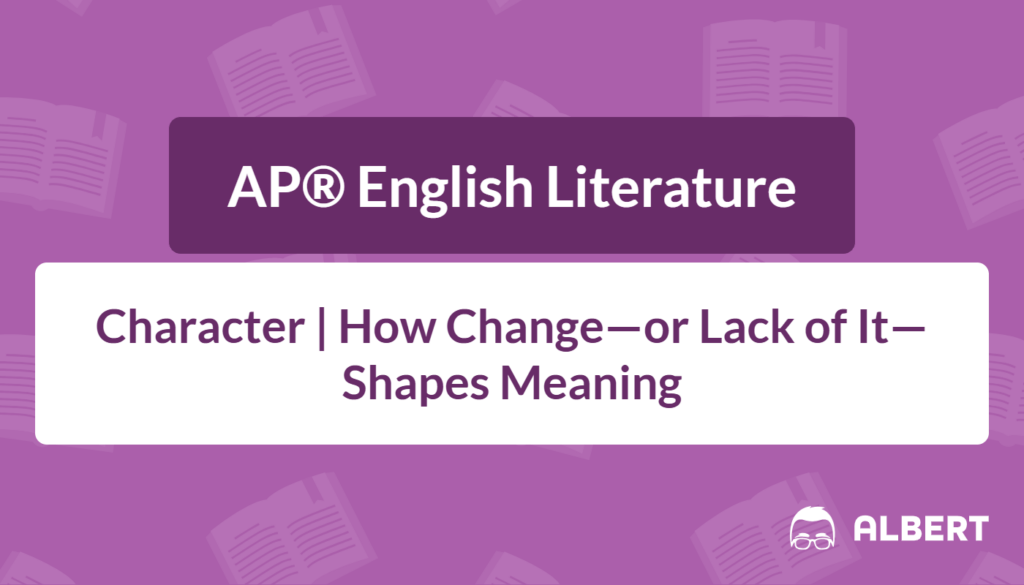What We Review
Character: How Change—or Lack of It—Shapes Meaning
Stories often revolve around memorable characters, and character development plays a crucial role in making those individuals stand out. Whether characters transform over time or remain consistent from beginning to end, their journeys reveal central themes and insights into the human experience. This post explores the difference between dynamic and static characters, showing how each type can contribute to a story’s overall meaning. Understanding these distinctions is especially valuable in the context of the AP® Literature exam, where analyzing character is a key skill.
What Is Character Development?
A character’s journey becomes more engaging when readers see how people change—or why they refuse to. Character development refers to the process of showing a character’s personality, beliefs, and growth throughout a narrative. Some characters experience profound transformation as the plot unfolds. Others remain relatively unchanged, helping highlight specific themes or other characters’ journeys.
Well-written characters drive the narrative forward by creating tension and conflict. They make decisions that influence the plot and reflect deeper issues or values. In short fiction, character development might happen quickly due to limited space. In longer fiction and drama, there is more room to show progression or stagnation in a character’s thoughts and actions.
Example from Literature:
Elizabeth Bennet in Jane Austen’s “Pride and Prejudice” demonstrates how character development can shape a story. Early in the novel, Elizabeth prides herself on her discernment: “I hope I never ridicule what is wise or good. Follies and nonsense, whims and inconsistencies do divert me, I own, and I laugh at them whenever I can” (Austen). The remark reveals both her wit and potential blindness to her own biases. Over time, Elizabeth’s evolving perspective on Mr. Darcy highlights her willingness to question first impressions.
How to Trace a Character’s Evolving Perspective:
- Look for early statements or decisions that reflect a character’s worldview.
- Identify moments when this worldview is challenged by plot events.
- Evaluate the result: Does the character open up to new ideas, or does pride keep them from changing?
This process of discovery underscores the idea that character development is not just about altering personality traits but also about revealing how characters respond to new information or conflicts.

Dynamic Characters
A dynamic character undergoes significant change over the course of a story. This transformation might be gradual, such as a shift in attitude, or sudden, triggered by a dramatic event. Either way, the internal evolution of a dynamic character usually helps illuminate major themes.
Literary works often use dynamic characters to illustrate moral, social, or personal growth. Many protagonists in classic and modern drama exemplify this pattern. In Shakespeare’s plays, for instance, characters like Prince Hal evolve from carefree youths to responsible leaders, reflecting deeper motifs about duty and identity. In contrast, some dynamic changes highlight a character’s tragic downfall, such as Macbeth succumbing to ambition.
Example from Literature:
Ebenezer Scrooge in Charles Dickens’s “A Christmas Carol” exhibits one of the most famous transformations in English literature. Initially, Scrooge is cold and uncaring: “Are there no prisons?…And the Union workhouses?” (Dickens). This line shows his indifference to the poor. After encountering spirits from his past, present, and future, he realizes the importance of empathy and community. By the end, he becomes generous and forgiving.
How to Analyze a Character’s Transformation:
- Identify the character’s initial mindset or behavior.
- Track specific plot events or conversations that challenge or shake their perspective.
- Observe the final state of the character. Has the person fundamentally changed, or did they only adopt a surface-level adjustment?
By focusing on these moments, readers gain insights into the moral or thematic relevance of a dynamic character’s growth.
Static Characters
A static character remains fundamentally the same throughout a narrative. This stability might seem less dramatic, yet it serves an important purpose. Static characters often highlight the transformations of others or embody a particular set of values that the story examines. They sometimes act as foils, enhancing readers’ perceptions of a dynamic character’s changes.
These characters appear in every genre, including short fiction and drama. In longer fiction, a static character might serve as a moral center, an unchanging beacon against which changing social environments can be measured. While their lack of growth could seem uninteresting at first, static characters can preserve continuity and maintain certain tensions that make the story compelling.
Example from Literature:
Sherlock Holmes, created by Sir Arthur Conan Doyle, is renowned for remaining largely consistent across multiple stories. Holmes’s investigative approach and logical mindset do not transform in any significant way. He confidently proclaims, “I never guess. It is a shocking habit—destructive to the logical faculty.” This unwavering characteristic is a key to his success, and it allows readers to focus on the changing circumstances of each mystery rather than Holmes’s internal growth.
How to Understand the Role of Unchanging Characters:
- Determine the character’s recurring traits or habits.
- Check if key events challenge those traits or simply reaffirm them.
- Compare how static characters interact with others who do change, emphasizing the broader themes at work.
Static characters might not progress internally, but they can still illuminate important conflicts or support a story’s central ideas.
Static vs. Dynamic Character Comparison
When analyzing static vs. dynamic characters, consider how each type fulfills a unique function:
- A dynamic character undergoes change that usually ties to the narrative’s central themes.
- A static character remains stable, often serving as a contrast to or anchor for others in the story.
Below is a quick side-by-side look at how these two character types typically work:
- Dynamic: Shows conflict, growth, and introspection.
- Static: Maintains consistent traits and reactions.
- Dynamic: Highlights broader evolutions within a story’s society or a personal moral compass.
- Static: Provides contrast, foil, or thematic steadiness.
Each approach shapes the meaning of the text. The presence of both types within the same work can reveal how transformation (or refusal to transform) impacts the story’s central message.
The Impact of Character Change on Themes
Character change—subtle or dramatic—often parallels the broader issues a work addresses. In many classics, a character’s arc speaks directly to topics like ambition, identity, or social pressures. Meanwhile, a lack of change can emphasize the inevitability of certain outcomes or the rigidity of institutions.
Example from Literature:
In F. Scott Fitzgerald’s “The Great Gatsby,” Jay Gatsby’s character development illustrates the height of the American Dream illusion. Initially, he is fueled by a nearly obsessive pursuit: “Can’t repeat the past? … Why of course you can!” (Fitzgerald). This brief line showcases Gatsby’s idealistic denial of reality. Over time, his unwavering belief in material success and love for Daisy unravels. Though Gatsby clings to his dream, readers see how his illusions collide with social divides and personal delusion. This transformation—both in the sense of his extraordinary rise and the shattering of his hopes—reinforces themes of idealism versus reality.
How to Analyze Character Change and Theme:
- Identify the themes the character’s journey might represent.
- Compare the character’s starting dreams or flaws to the final outcome.
- Examine how the author uses symbols, dialogue, or other literary techniques to punctuate the character’s changes or stubbornness.
In many AP® Lit texts, characters like Hamlet or Frankenstein’s monster mirror deeper philosophical or ethical concerns. Observing how their shifts in perspective (or lack thereof) influence the narrative offers exam readers a rich field for analysis.
Conclusion
Whether a story spans a few pages or unfolds on the stage, character development remains a cornerstone of literary analysis. Recognizing the difference between dynamic characters who undergo growth and static characters who stay constant can unlock powerful meanings embedded in the text. These insights can guide interpretive essays, classroom discussions, and AP® Literature responses, highlighting the interplay between a character’s decisions and the work’s larger themes. Examining the complex journeys of figures like Elizabeth Bennet, Ebenezer Scrooge, Sherlock Holmes, or Jay Gatsby ultimately enriches an understanding of how fiction and drama reflect real-world beliefs, dreams, and conflicts.
Quick Reference Chart: Vocabulary and Definitions
| Term | Definition |
| Character Development | The process of creating and evolving a character throughout a story. |
| Dynamic Character | A character who undergoes significant internal change or growth over the course of the narrative. |
| Static Character | A character who remains the same throughout the story and does not experience significant changes. |
| Static vs. Dynamic | A comparison of how characters evolve in fiction or drama: static characters do not change, while dynamic characters do. |
Understanding why a character changes—or why that character refuses to—brings deeper insight into the author’s overarching message. The interplay between static and dynamic characters can draw readers into the heart of a story, shedding light on the timeless truths and profound questions at play.
Sharpen Your Skills for AP® English Literature and Composition
Are you preparing for the AP® English Literature and Composition test? We’ve got you covered! Try our review articles designed to help you confidently tackle real-world AP® English Literature and Composition problems. You’ll find everything you need to succeed, from quick tips to detailed strategies. Start exploring now!
- AP® English Literature: Character Analysis
- AP® English Literature: Foil Character
- AP® English Literature: Character Dynamics
- AP® English Literature: Complex Character
Need help preparing for your AP® English Literature and Composition exam?
Albert has hundreds of AP® English Literature and Composition practice questions, free response, and full-length practice tests to try out.








